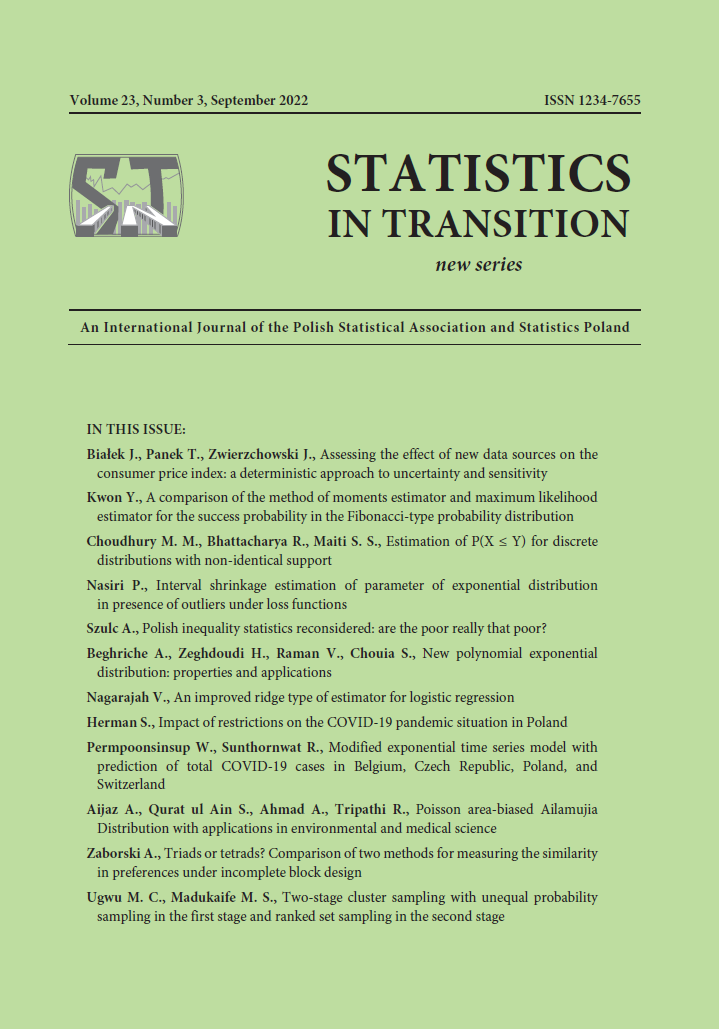ARTICLE
ABSTRACT
A Fibonacci-type probability distribution provides the probabilistic models for establishing stopping rules associated with the number of consecutive successes. It can be interpreted as a generalized version of a geometric distribution. In this article, after revisiting the Fibonaccitype probability distribution to explore its definition, moments and properties, we proposed numerical methods to obtain two estimators of the success probability: the method of moments estimator (MME) and maximum likelihood estimator (MLE). The ways both of them performed were compared in terms of the mean squared error. A numerical study demonsrated that the MLE tends to outperform the MME for most of the parameter space with various sample sizes.
KEYWORDS
Fibonacci probability distribution, generalized polynacci distribution, factorial moment generating function, method of moments, maximum likelihood estimator
REFERENCES
Albert, G. E., (1943). An Inductive Proof of Descartes’ Rule of Signs, The American Mathematical Monthly, 50(3), pp. 178–180.
Das, N., (2003). Study on Implementing Control Charts Assuming Negative Binomial Distribution with Varying Sample Size in a Software Industry. Software Quality Professional, 6, pp. 38–39.
Ma, Y., Zhang, Y., (1996). Q control charts for negative binomial distribution. Computers & Industrial Engineering, 31(3), pp. 813–816.
De Moivre, A. (1756). The Doctrine of Chances, 3rd ed., Chelsea Publishing Co., New York (reprint, 1967).
Philippou, A. N., Antzoulakos, D., (1990). Multivariate Fibonacci polynomials of order k and the multiparameter negative binomial distribution of the same order, G. E. Bergum (ed.) A. N. Philippou (ed.) A. F. Horadam (ed.), Applications of Fibonacci Numbers 3, Kluwer Academic Publishers, pp. 273–279.
Philippou, A. N., Antzoulakos, D., (1991).Generalized Multivariate Fibonacci Polynomials of Order k and the Multivariate Negative Binomial Distributions of the Same Order. The Fibonacci Quarterly, 29, 322–328.
Philippou, A. N., Georghiou, C., (1989). Convolutions of Fibonacci-type polynomials of order k and the negative binomial distributions of the same order. The Fibonacci Quarterly, 27(3), pp. 209–216.
Philippou, A. N., Georghiou, C., Philippou, G. N., (1983). Fibonacci polynomials of order k, multinomial expansions and probability. International Journal of Mathematics and Mathematical Sciences, 6(3), pp. 545–550.
Philippou, A. N., Georghiou, C., Philippou, G. N., (1985). Fibonacci-type polynomials of order k with probability applications. The Fibonacci Quarterly, 23(2), pp. 100–105.
Philippou, A. N., Makri, D. S., (1985). Longest Success Runs and Fibonacci-type Polynomials of Order k. The Fibonacci Quarterly, 23(4), pp. 338–346.
Philippou, A. N., Muwafi, A. A., (1982). Waiting for the k-th consecutive success and the Fibonacci sequence of order k. The Fibonacci Quarterly, 20(1), pp. 28–32.
Shane, H. D., (1973). A Fibonacci Probability Function. The Fibonacci Quarterly, 11(6), pp. 517–522.
Turner, S. J., (1979). Probability via the N-th Order Fibonacci-T Sequence. The Fibonacci Quarterly, 17(1), pp. 23–28.
